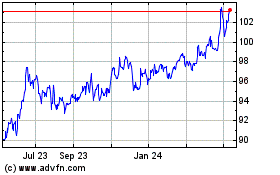Australian Dollar Rises On Strong Consumer Inflation Data
24 April 2024 - 1:43PM
RTTF2
The Australian dollar strengthened against other major
currencies in the Asian session on Wednesday, following the release
of Australia's higher-than-expected consumer prices on quarter in
the first quarter of 2024.
Data from the Australian Bureau of Statistics showed that the
consumer prices in Australia were up a seasonally adjusted 1.0
percent on quarter in the first quarter of 2024. That exceeded
expectations for an increase of 0.8 percent and accelerated from
0.6 percent in the three months prior.
On a yearly basis, inflation climbed 3.6 percent - again topping
forecasts for 3.4 percent but slowing from 4.1 percent in the
previous three months.
The robust inflation data spurred expectations that the Reserve
Bank of Australia is unlikely for an early interest rate cut.
The Asian stock markets traded higher, as data showing a
slowdown in U.S. manufacturing activity in the month of April
raised hopes the U.S. Fed will start thinking of cutting interest
rates soon. Traders also continue to pick up stocks at relatively
reduced levels after the recent sell-off.
Traders now await more economic data later in the week,
including the release of first-quarter U.S. GDP data as well as the
core personal-consumption expenditures (PCE) price index, which is
the Fed's preferred measure of inflation. This ahead of the next
Federal Open Market Committee meeting on April 30-May 1.
The Australian dollar started trading higher against its major
rivals from April 19, 2024.
In the Asian trading today, the Australian dollar rose to nearly
a 10-year high of 101.07 against the yen and a 10-month high of
1.0983 against the NZ dollar, from yesterday's closing quotes of
100.42 and 1.0932, respectively. If the aussie extends its uptrend,
it is likely to find resistance around 102.00 against the yen and
1.10 against the kiwi.
Against the U.S. dollar, the euro and the Canadian dollar, the
aussie advanced to near 2-week highs of 0.6530, 1.6408 and 0.8916
from Tuesday's closing quotes of 0.6485, 1.6490 and 0.8861,
respectively. The aussie may test resistance near 0.67 against the
greenback, 1.63 against the euro and 0.90 against the loonie.
The other antipodean currency or the NZ dollar also strengthened
against its most major rivals, amid risk appetite and following the
release of Australia's inflation data.
The NZ dollar rose to near 2-week highs of 0.5952 against the
U.S. dollar and 92.14 against the yen, from yesterday's closing
quotes of 0.5930 and 91.85, respectively. If the kiwi extends its
uptrend, it is likely to find resistance around 0.61 against the
greenback and 93.00 against the yen.
Against the euro, the kiwi edged up to 1.7997 from Tuesday's
closing value of 1.8033. The kiwi may test resistance near the 1.78
region.
Looking ahead, Germany Ifo business climate index for April and
U.K. Confederation of British Industry's industrial trends survey
results for April are due to be released in the European
session.
In the New York session, U.S. MBA mortgage approvals data,
Canada retail sales data for February, manufacturing sales data for
March, U.S. durable goods orders for March and U.S. EIA crude oil
data are slated for release.
AUD vs Yen (FX:AUDJPY)
Forex Chart
From Apr 2024 to May 2024

AUD vs Yen (FX:AUDJPY)
Forex Chart
From May 2023 to May 2024
